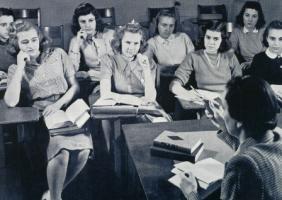Excursions and Lectures

From the very beginning of the school, the opportunity for field trips and excursions to national monuments and museums was promoted as a key advantage of the school’s location in the Washington region. Clair Rountree’s chaperoned excursion to Mount Vernon in the 1920s was not unusual, and visits to the White House, Capitol Hill, and the national museums, among other attractions, were annual events.
This picture, in the collection of the Library of Congress, shows the girls on a trip to the White House in 1926.
Advice from Speakers
In the 1920s and 1930s, a series of lectures organized by the Farringtons brought noted writers, artists, and politicians to the campus. For example in 1932, The Washington Post published a list of speakers for the year. It includes the writers Hamlin Garland and Thornton Wilder, along with Mrs. Amelia Earhart Putnam, aviatrix, surely an exciting speaker! In 1939, Mrs. Henry Grattan Doyle, the president of the Board of Education for the District of Columbia and the wife of the Chevy Chase provost, spoke to Chevy girls about the importance of relaxing at work. According to a newspaper account in The Washington Post, “in her opinion men take to jobs much more naturally and do not labor under the same tenseness as women.” We don’t know how the Chevy students took this advice, but by this period, many were thinking about working, if not instead of marriage, at least in the years before marriage.
A 'New Program of Study' for Chevy Chase Junior College

By the early 1940s, the school formally changed its name to Chevy Chase Junior College and incorporated as a Maryland non-profit institution. President Kendric Nichols Marshall developed a new program of study immediately upon coming to the school in 1940. Offering advanced study in political problems, his new curriculum emphasized a laboratory technique where students observed government in action, and students conducted primary source research to supplement their reading, lectures, and seminars.
Quoted in the Washington Post, Marshall described the new program by saying:




